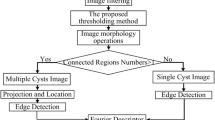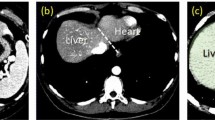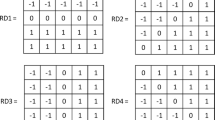Abstract
An optimal contour segmentation for ultrasonic liver cyst image is presented through combining graph-based method with particle swarm optimization (PSO) in this paper. After automatic selecting the region of interest (ROI) for ultrasonic liver cyst image, our method developed firstly a kind of multiple classes merging scheme by jointing the graph-based segmented result with the intensity of original ultrasound image. Then the evaluation function in the PSO was modified to optimize the parameter. Finally, the liver cysts were segmented according to the optimized parameter. In the experiment, we tested the influence of weight value on the improved method. And five indicators, which included Hausdorff distance (HD), mean absolute distance (MD), true positive volume fraction (TPVF), false-negative volume fraction (FNVF) and false-positive volume fraction (FPVF), were estimated to verify the improved method. Experimental results have validated that the improved method may extract successfully and accurately the contour of liver cyst.










Similar content being viewed by others
References
Abdolali F, Zoroofi RA, Otake Y, Sato Y (2016) Automatic segmentation of maxillofacial cysts in cone beam CT images. Comput Biol Med 72:108–119
Bernier M, Jodoin PM, Humbert O et al (2017) Graph cut-based method for segmenting the left ventricle from MRI or echocardiographic images. Comput Med Imaging Graph 58:1–12
Y. Boykov and M. Jolly. Interactive graph cuts for optimal boundary ®ion segmentation of objects in N-D images. Proc Int Conf Comput Vision, Vancouver, Canada, July, vol. I, p. 105–112, 2001
Boykov Y, Kolmogorov V (2004) An experimental comparison of min-cut/max-flow algorithms for energy minimization in vision. IEEE Trans Pattern Anal Mach Intell 26(9):1124–1137
Ciurte A, Bresson X, Cuisenaire O et al (2014) Semi-supervised segmentation of ultrasound images based on patch representation and continuous min cut. Plos One 9(7):e100972
Felzenszwalb PF, Huttenlocher DP (2004) Efficient graph-based image segmentation. Int J Comput Vision 59(2):167–181
Grady L (2006) Random walks for image segmentation. IEEE Trans Pattern Anal Mach Intell 28(11):1768–1733
Grady L, Schwartz E (2006) Isoperimetric graph partitioning for image segmentation. IEEE Trans Pattern Anal Mach Intell 28(3):469–475
Huang Q, Lee S, Liu L, Lu M, Jin L, Li A (2012) A robust graph-based segmentation method for breast tumors in ultrasound images. Ultrasonics 52:266–275
Huang Q, Bai X, Li Y, Jin L, Li X (2014) Optimized graph-based segmentation for ultrasound images. Neurocomputing 129:216–224
Ju W, Xiang D, Zhang B et al (2015) Random walk and graph cut for co-segmentation of lung tumor on PET-CT images. IEEE Trans Image Process 24(12):5854–5867
Kennedy J, Eberhart R (1995) Particle swarm optimization. Proc IEEE Int Conf Neural Netw, Perth, Australia 4:1942–1948
Kiruthika V, Ramya MM (2014) Automatic segmentation of ovarian follicle using K-means clustering. Proc Int Conf Sign Image Process: 137–141
Kuo J, Mamou J, Wang Y et al (2017) Segmentation of 3-D high-frequency ultrasound images of human lymph nodes using graph cut with energy functional adapted to local intensity distribution. IEEE Trans Ultrason Ferroelectr Freq Control 64(10):1514–1525
Lee WL, Chen YC, Hsieh KS (2005) Unsupervised segmentation of ultrasonic liver images by multiresolution fractal feature vector. Inf Sci 175:177–199
Li Y, Huang Q, Jin L (2012) A parameter-automatically-optimized graph-based segmentation method for breast tumors in ultrasound images. Proc 31st Chin Contrl Conf, July 25–27, Hefei, China: 4007–4011
Lu F, Wu F, Hu P et al (2017) Automatic 3D liver location and segmentation via convolutional neural network and graph cut. Int J Comput Assist Radiol Surg 12(2):171–182
Mukherjee S, Huang X, Bhagalia RR (2017) Lung nodule segmentation using deep learned prior based graph cut, 2017 I.E. 14th International Symposium on Biomedical Imaging: 1205–1208
Otsu N (1979) A threshold selection method from grey level histogram. IEEE Trans Syst Man Cybern 9(1):62–66
Ozic MU, Ozbay Y, Baykan OK (2014) Detection of tumor with Otsu-PSO method on brain MR image, Sign Process Commun Appl Conf: 1999–2002
Saito A, Nawano S, Shimizu A (2017) Fast approximation for joint optimization of segmentation, shape, and location priors, and its application in gallbladder segmentation. Int J Comput Assist Radiol Surg 12(5):743–756
Shi J, Malik J (2000) Normalized cuts and image segmentation. IEEE Trans Pattern Anal Mach Intell 22(8):888–905
Torbati N, Ayatollahi A, Kermani A (2014) An efficient neural network based method for medical image segmentation. Comput Biol Med 44:76–87
Zhang Q, Huang C, Li C, Yang L, Wang W (2012) Ultrasound image segmentation based on multi-scale fuzzy c-means and particle swarm optimization. IET Int Conf Info Sci Contrl Eng 636:1–5
Zheng Q, Warner S, Tasian G, et al. (2017) A dynamic graph-cuts method with integrated multiple feature maps for segmenting kidneys in ultrasound images. arXiv preprint arXiv:1706.03372
Zhu H, Sheng J, Zhang F, Zhou J, Wang J (2016) Improved maximally stable extremal regions based method for the segmentation of ultrasonic liver images. Multimed Tools Appl 75(18):10979–10997
Zhu H, Zhuang Z, Zhou J, Zhang F, Wang X, Wu Y (2017) Segmentation of liver cyst in ultrasound image based on adaptive threshold algorithm and particle swarm optimization. Multimed Tools Appl 76:8951–8968
Acknowledgements
This work was supported in part by the National Natural Science Foundation of China under grant No.61672084 and No. 61473025 and the open-project grant funded by the State Key Laboratory of Synthetical Automation for Process Industry at the Northeastern University in China. We also thank the reviewers’ comments for this manuscript and Mr. Tengfei Yang, who participated in technical editing of the manuscript.
Author information
Authors and Affiliations
Corresponding author
Rights and permissions
About this article
Cite this article
Zhu, H., Zhuang, Z., Zhou, J. et al. Improved graph-cut segmentation for ultrasound liver cyst image. Multimed Tools Appl 77, 28905–28923 (2018). https://doi.org/10.1007/s11042-018-6076-4
Received:
Revised:
Accepted:
Published:
Issue Date:
DOI: https://doi.org/10.1007/s11042-018-6076-4




